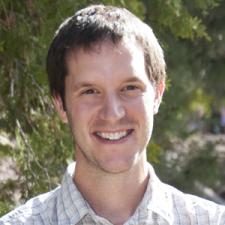Chris Guiterman - 2014 CLIMAS Climate & Society Graduate Fellow
 From the very beginning, Chris Guiterman just wanted an opportunity to expand his collaboration with the Navajo Forestry Department, and to demonstrate what he could do to help them.
From the very beginning, Chris Guiterman just wanted an opportunity to expand his collaboration with the Navajo Forestry Department, and to demonstrate what he could do to help them.
Guiterman is a 2014 recipient of the Climate Assessment for the Southwest (CLIMAS) Climate & Society Graduate Fellows Program. He is currently a PhD student at the University of Arizona, School of Natural Resources and the Environment, working in the Laboratory of Tree-Ring Research.
He used the CLIMAS fellowship to jumpstart a project that he had been struggling to fund.
Tribal nations across the Southwest are increasingly at risk of climate change impacts on the landscape, and because many of these nations rely on the ecosystem services of healthy forests, the risks are intensified.
“Tasked with managing over 5 million acres of forests and woodlands, the Navajo Forestry Department has identified the need to assess sensitivities of their forests to drought and climate change,” according to the abstract of Guiterman’s research project. Guiterman worked with the NFD foresters to address their needs by quantifying the climatic drivers of forest growth in the Chuska Mountains.
Previously, Guiterman worked with the NFD on another project for a couple of years, and he and his NFD collaborators had a series of discussions about what the next steps could be. Guiterman basically told the NFD, “you can see what I can do…what do you need? And what can I do for you?”
Guiterman said the project spawned from that initial conversation, and the NFD essentially asked him the research questions.
They wanted to know how vulnerable their forests are to climate change, what the long-term productivity of their forests would look like, and the overall age of the forests.
“I was really excited to be able to contribute and to be able to give them some knowledge that they want, and that I actually have the skills and capacity to do,” Guiterman said. “I understand what it is like to be a forest manager from my background, so I know how valuable this information is.”
This was a win-win for both the NFD and Guiterman. He found the research compelling because it was at the core of what he does as a scientist, and it was also directly beneficial to a group who needed this information and analysis, and who had plans to use it.
When Guiterman approached CLIMAS with this study, he knew that his ambitions were bigger than the five thousand dollar budget CLIMAS allowed. But he didn’t care.
“I told the Navajo foresters I could do something when they asked me a question,” Guiterman said. “I told them I could help answer it and I just wanted a start to show them that we could go in the woods, we could all core trees, I could bring back data and show them x,y and z to help answer their questions.”
Throughout this project, Guiterman learned a lot about what it means to work on a Native American reservation. Because the tribal government functions differently than he is used to, he had to learn as he went along. “I think I jumped a few hurdles before I ever knew they existed and then I backed up,” Guiterman said. “They were willing to work with me, be patient and understanding.”
Although learning the rules and regulations was difficult at first for Guiterman, it was also very rewarding. “Trust and credibility in a relationship are paramount to doing the kind of work that I want to keep doing and what this project emphasizes,” said Guiterman.
Guiterman worked in the field with two men from the NFD, who had been there for at least 20 years, and they helped core most of the trees. The fieldwork was complete in June of 2014. They visited 7 plots, cored 111 trees and took 222 cores back to the lab.
“I learned a lot just by being around them in the woods, asking what they saw and what they thought,” Guiterman said.
One thing Guiterman wasn’t expecting was how much they taught him about navigating the road network in the area. “There are roads everywhere and there are few markers, some of them aren’t even on the map,” Guiterman said. “Local knowledge is so key when you are in the forest landscape.”
This project took the men out to plots in the middle of the forest, so Guiterman usually gave the Navajo foresters the plot locations and he would follow behind so he wouldn’t get lost.
“We would be driving along and we would just turn off the road into what to me looked like a meadow and drive on up,” Gutierman said. “A couple of times they would disappear and I would have no idea where they were going because I didn’t see the road there.”
As Guiterman followed, a road would appear. Somehow, the foresters knew it would be there.
Guiterman was able to begin his research with the CLIMAS fellowship, and has subsequently received a fellowship from The Environmental Protection Agency (EPA Star) and a grant from the Bureau of Indian Affairs (BIA). With this extra funding, Guiterman has been able to make this project part of his dissertation, which he intends to finish in August of 2016.
Guiterman is also excited to finally be a part of CLIMAS. He has always admired their work and with this fellowship, not only did he get to do this project, but he also joined a community of people that he wants to work with.

